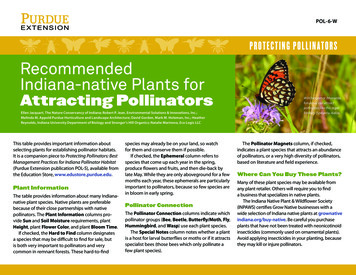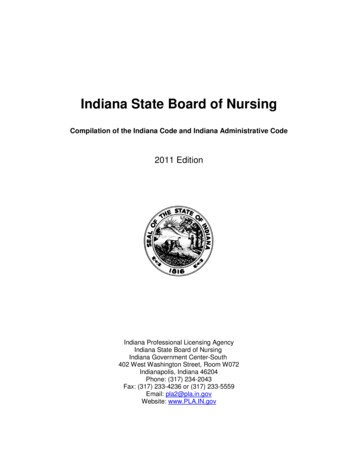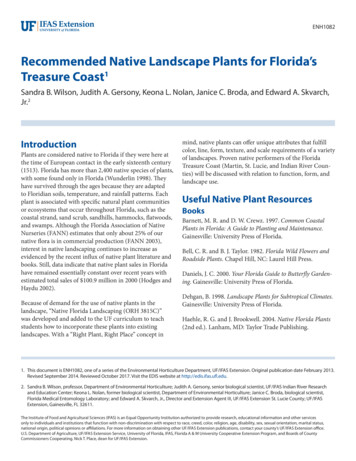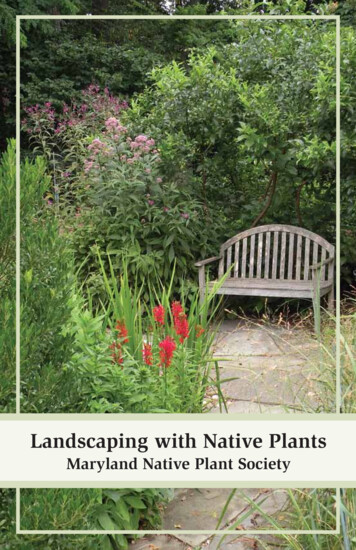
Transcription
POL-6-WPR O T EC T ING P OLLIN AT OR SRecommendedIndiana-native Plants forAttracting PollinatorsEllen Jacquart, The Nature Conservancy of Indiana; Robert P. Jean, Environmental Solutions & Innovations, Inc.;Melinda M. Appold Purdue Horticulture and Landscape Architecture; David Gorden, Mark M. Holeman, Inc.; HeatherReynolds, Indiana University Department of Biology and Stranger’s Hill Organics; Natalie Marinova, Eco Logic LLCThis table provides important information aboutselecting plants for establishing pollinator habitats.It is a companion piece to Protecting Pollinators: BestManagement Practices for Indiana Pollinator Habitat(Purdue Extension publication POL-5), available fromthe Education Store, www.edustore.purdue.edu.Plant InformationThe table provides information about many Indiananative plant species. Native plants are preferablebecause of their close partnerships with nativepollinators. The Plant Information columns provide Sun and Soil Moisture requirements, plantHeight, plant Flower Color, and plant Bloom Time.If checked, the Hard to Find column designatesa species that may be difficult to find for sale, butis both very important to pollinators and verycommon in remnant forests. These hard-to-findspecies may already be on your land, so watchfor them and conserve them if possible.If checked, the Ephemeral column refers tospecies that come up each year in the spring,produce flowers and fruits, and then die-back bylate May. While they are only aboveground for a fewmonths each year, these ephemerals are particularlyimportant to pollinators, because so few species arein bloom in early spring.Pollinator ConnectionThe Pollinator Connection columns indicate whichpollinator groups (Bee, Beetle, Butterfly/Moth, Fly,Hummingbird, and Wasp) use each plant species.The Special Notes column notes whether a plantis a host for larval butterflies or moths or if it attractsspecialist bees (those bees which only pollinate afew plant species).Wild bergamot (Monardafistulosa) can attractpollinators like this regalfritillary (Speyeria idalia).The Pollinator Magnets column, if checked,indicates a plant species that attracts an abundanceof pollinators, or a very high diversity of pollinators,based on literature and field experience.Where Can You Buy These Plants?Many of these plant species may be available fromany plant retailer. Others will require you to finda business that specializes in native plants.The Indiana Native Plant & Wildflower Society(INPAWS) certifies Grow Native businesses with awide selection of Indiana native plants at grownativeindiana.org/buy-native. Be careful you purchaseplants that have not been treated with neonicotinoidinsecticides (commonly used on ornamental plants).Avoid applying insecticides in your planting, becausethey may kill or injure pollinators.
Wildflowers*Common NameLatin NamePlant InformationPollinator ConnectionSunSoil Moisture.HeightFlowerBloomHardEphemeralBeeBeetle Butterfly/ Fly Hummingbird Wasp Special NotesColorTimeto Find MothFullPartShadeWetWetMesicDryDrySunShade Mesic Mesicsweet flagnodding wild onionrue anemonecolumbinegoat’s beardwild gingermarsh milkweedSullivant’s milkweedcommon milkweedbutterflyweedwhorled milkweedsky-blue asterheart-leaved blue wood asterheath astershining astersmooth astercalico asterNew England asterswamp asterShort’s asterflat-topped asterblue false indigowhite false indigocream false indigotickseed sunflowerfalse astermarsh marigoldspring cresscut-leaved toothwortwild sennablue cohoshwhite turtleheadpink turtleheadspring beautyblue-eyed Marylance-leaf coreopsisplains coreopsistall coreopsispurple prairie cloverdwarf larkspurpale purple coneflowerpurple coneflowerharbinger of springrattlesnake masterwhite trout lilyyellow trout lilytall bonesetAcorus calamusXXXAllium cernuumXXXXXAnemonella thalictroidesXXXXXXAquilegia canadensisXXXXXXAruncus dioicusXXXXAsarum canadenseXXXXXXAsclepias incarnataXXXXAsclepias sullivantiiXXXAsclepias syriacaXXXXXAsclepias tuberosaXXXXAsclepias verticillataXXXXAster azureusXXXXAster cordifoliusXXXXAster ericoidesXXXXAster firmusXXXXAster laevisXXXXXAster lateriflorusXXXXXXXAster novae-angliaeXXXXXAster puniceusXXXXAster shortiiXXXAster umbellatusXXXXBaptisia australisXXXBaptisia leucanthaXXXXXBaptisia leucophaeaXXXXBidens aristosaXXXBoltonia latisquamaXXXCaltha palustrisXXXXXCardamine bulbosaXXXXXCardamine concetenataXXXXXCassia hebecarpaXXXCaulophyllum thalictroidesXXXXChelone glabraXXXXChelone obliquaXXXXClaytonia virginicaXXXXXCollinsia vernaXXXXCoreopsis lanceolataXXXCoreopsis palmataXXXXCoreopsis tripterisXXXXDalea purpureaXXXXDelphinium tricorneXXXXXEchinacea pallidaXXXXXEchinacea purpureaXXXXXErigenia bulbosaXXXXXXEryngium yuccifoliumXXXXXErythronium albidumXXXXXXErythroniun americanumXXXXXXEupatorium altissimaXXXXXXCommon NameLatin Name2’-3’1’-2’ 1’1’-3’4’-6’ ��-4’1’1’-4’3’-6’1’-2’ 1’ 1’3’-5’2’-4’2’-4’2’-4’ 1’ 1’1’-2’1’-2’6’-8’1’-2’ 1’2’-4’3’-4’ 1’3’-4’ 1’ 1’3’-4’greenpinkwhitered - mersummerspringspring/summersummerspringsummer/ y azure host*monarch hostmonarch hostmonarch hostmonarch hostmonarch hostpearl crescent hostpearl crescent hostpearl crescent hostpearl crescent hostpearl crescent hostpearl crescent hostpearl crescent hostpearl crescent hostpearl crescent hostpearl crescent hostsilver-spotted skipper host*XXXXXXXXXXXXXXXXXXPlant XXXXXXXXXXXXXXXXXXXXXXXXXXXXXXXXXXXXXXXXdainty sulphur host*bee specialistbee specialist; West Virginia white hostcloudless sulphur and sleepy orange host*XXXX*XXXXXXXXXXXPollinator ConnectionXXXXXBaltimore checkerspot hostBaltimore checkerspot hostbee specialist**XXdogface sulphur hostXXXXXXXXvery early resourceblack swallowtail host**
Wildflowers* (continued)Common NameLatin NamePlant InformationPollinator ConnectionSunSoil MoistureHeightFlowerBloomHardEphemeralBeeBeetle Butterfly/ Fly Hummingbird Wasp Special NotesColorTimeto Find MothFullPartShadeWetWetMesicDryDrySunShade Mesic Mesicblue mist flowerEupatorium coelestinumXXXX1’-2’bluefallXXXXhollow joe-pye weedEupatorium fistulosumXXXX4’-9’pinkfallXXspotted joe-pye weedEupatorium maculatumXXX4’-6’pinkfallXXXsweet joe-pye weedEupatorium purpureumXXXXX4’-6’pinksummerXXXXwhite snakerootEupatorium rugosumXXX2’-4’whitefallXXXXlate bonesetEupatorium serotinumXXXX3’-6’whitefallXXXXXqueen of the prairieFilipendula rubraXXX4’-7’pinksummerXXXbottle gentianGentiana andrewsiiXXXX1’-2’bluefallXwild geraniumGeranium maculatumXXXX1’lt. purp.springXXXbee specialistautumn sneezeweedHelenium autumnaleXXXX3’-5’yellowfallXXXsilvery checkerspot hostwoodland sunflowerHelianthus divaricatusXXXX2’-6’yellowsummerXXXbee specialist, painted lady hostdowny sunflowerHelianthus mollisXXXX2’-4’yellowsummerXXXXbee specialist, painted lady hostwestern sunflowerHelianthus occidentalisXXXX2’-3’yellowsummerXXXXbee specialist, painted lady hostshowy sunflowerHelianthus rigidusXXXX3’-5’yellowsummerXXXXbee specialist, painted lady hostfalse sunflowerHeliopsis epatica nobilisXXXXX 1’purplespringXXXvery early resource, pollen onlyalum rootHeuchera americanaXXX1’-2’wht-grnsummerXswamp rose mallowHibiscus moschuetosXXX3’-6’wht-pinksummerXbee specialist, commoncheckered-skipper hostXXXX1’-2’lavenderspringXXXXbee specialistgreat waterleafHydrophyllumappendiculatumblue flag irisIris virginica shreveiXXXX2’-3’bluespring/summerXXrough blazing starLiatris asperaXXXX1’-3’purplesummer/ fallXXXXmeadow blazing starLiatris ligulistylisXXX1’-3’rose/purple summerXXXXprairie blazing starLiatris pycnostachyaXXXX3’-5’purplesummerXXXXsavanna blazing starLiatris scariosa nieuwlandiiXXXX2’-3’purplesummerXXXXdense blazing starLiatris spicataXXXX3’-5’purplesummerXXXXcardinal flowerLobelia cardinalisXXXX1’-3’redsummerXXgreat blue lobeliaLobelia s perennisXXXX1’-2’bluespringXfringed loosestrifeprairie loosestrifeVirginia bluebellsmonkeyflowerbergamotprairie sundropsheart-leaved golden ragwortwild quininearrow arumsmooth penstemonfoxglove penstemonhairy penstemonfernleaf phaceliaobedient plantJacob’s ladderprairie cinquefoilnarrow leaf mountain mintLysimachia ciliataXXXXXLysimachia quadrifloraXXXXXMertensia virginicaXXXXMimulus ringensXXXMonarda fistulosaXXXXXOenothera pilosellaXXXPackera aureaXXXXXParthenium integrifoliumXXXXPeltandra virginicaXXPenstemon calycosusXXXXPenstemon digitalisXXXXPenstemon hirsutusXXXXXPhacelia bipinnatifidaXXXXPhysostegia virginianaXXXXPolemonium reptansXXXXPotentilla argutaXXXXPycnanthemum ringsummersummerspring/ summersummerspring/ *********pollen only; eastern tailed-blueand frosted elfin hostbee specialistbee specialistcommon buckeye hostXXXXXXXXXXXXPollinatorMagnetsXXXXXfly specialistXXbee specialistXXX*Xbee specialistX
Wildflowers* (continued)Common NameLatin NamePlant InformationPollinator ConnectionSunSoil MoistureHeightFlowerBloomHardEphemeralBeeBeetle Butterfly/ Fly Hummingbird Wasp Special NotesColorTimeto Find MothFullPartShadeWetWetMesicDryDrySunShade Mesic Mesiccommon mountain mintyellow coneflowerorange coneflowerblack-eyed Susansweet black-eyed Susancommon arrowheadlizard’s taildowny skullcapwild stonecroproyal catchflyrosinweedcompass plantcup plantprairie dockblue-stemmed goldenrodzigzag goldenrodearly goldenrodgray goldenrodOhio goldenrodRiddell’s goldenrodstiff goldenrodwrinkled goldenrodshowy goldenrodcelandine poppyspiderwortlarge-flowered trilliumblue vervaintall ironweedsmooth ironweedculver’s rootgolden alexandersPycnanthemum virginianumXXXXRatibida pinnataXXXRudbeckia fulgida speciosaXXXXRudbeckia hirtaXXXXRudbeckia subtomentosaXXXXSagittaria latifoliaXXSaururus cernuusXXXXScutellaria incanaXXXXXXSedum ternatumXXXXSilene regiaXXXXSilphium integrifoliumXXXXXSilphium laciniatumXXXXXSilphium perfoliatumXXXSilphium terebinthinaceumXXXXSolidago caesiaXXXXXSolidago flexicaulisXXXXXSolidago junceaXXXXSolidago nemoralisXXXXSolidago ohioensisXXXXSolidago riddelliiXXXXSolidago rigidaXXXXXSolidago rugosaXXXXSolidago speciosaXXXXXStylophorum diphyllumXXXXXTradescantia ohiensisXXXXXTrillium grandiflorumXXXXXVerbena hastataXXXXVernonia altissimaXXXVernonia fasciculataXXXVeronicastrum virginicumXXXXZizia owsummersummersummer/ fallsummersummer/ ngspring/ summerspringsummersummersummersummerspring/ XXXXXXXXXXXXXXXXXbee specialistbee specialistbee specialistbee specialistbee specialistbee specialistbee specialistbee specialistbee specialist*****bee specialist. buckeye hostXXXX*XXXXbee specialist, black swallowtail host*Trees and Shrubs*Trees and shrubs are a very important part of any pollinator planting, providing great amounts of nectar and pollen for pollinators.Common NameLatin NamePlant InformationPollinator ConnectionSunSoil MoistureHeightFlowerBloomHardEphemeralBeeBeetle Butterfly/ Fly Hummingbird Wasp Special NotesColorTimeto Find MothFullPartShadeWetWetMesicDryDrySunShade Mesic Mesicred maplesugar mapleOhio buckeyeserviceberryleadplantAcer rubrumAcer saccharumAesculus glabraAmelanchier arboreaAmorpha canescensXXXXXXXXXXXXXXXXXXXXXXXXXto 95’to 100’to MagnetsXXXXXstriped hairstreak hostsouthern dogface host*
Trees and Shrubs* (continued)Common NameLatin NamePlant InformationPollinator ConnectionSunSoil MoistureHeightFlowerBloomHardEphemeralBeeBeetle Butterfly/ Fly Hummingbird Wasp Special NotesColorTimeto Find MothFullPartShadeWetWetMesicDryDrySunShade Mesic Mesicindigo bushAmorpha fruticosaXXXX4’-16’purplesummerXXdevil’s walking stickAralia spinosaXXXX10’-20’whitesummerXXXXXXblack chokeberryAronia melanocarpaXXXX2’-4’whitesummerXXcoral hairstreak hostpawpawAsimina trilobaXXXX10’-40’purplespringXXzebra swallowtail hostNew Jersey teaCeanothus americanusXXXXX1’-3’whitesummerXXXXsummer azure and mottledduskywing hostbuttonbushCephalanthes rcis canadensisXXXXX20’-30’pinkspringXXXXXsilky dogwoodCornus amomumXXXX6’-12’whitesummerXbee specialist, summer azure hostgrey dogwoodCornus racemosaXXXXX10’-15’whitespringXbee specialist, summer azure hostpersimmonDiospyros virginianaXXXXXto 60’whitespringXXwinterberryIlex verticillataXXXXXX6’-15’whitesummerXHenry’s elfin hostspicebushLindera benzoinXXXX6’-12’yellowspringXXeastern tiger , black, and spicebushswallowtail hosttulip treeLiriodendron tulipiferaXXXXX70’-100’ yellowspringXninebarkPhysocarpus opulifoliusXXXX5’-8’whitespring/ summerXXXshrubby cinquefoilPotentilla fruticosaXXXXX2’-4’yellowsummerXXblack cherryPrunus ets***eastern tiger swallowtail hostDorcas copper hosteastern tiger swallowtail, red-spottedpurple and coral hairstreak hostfragrant sumacRhus aromaticaXXXXX2’-6’yellowspringXXXXwinged sumacRhus copallinumXXXXX7’-15’greensummerXXXXred-banded hairstreak hostprairie willowSalix humilisXXXXX2’-8’greenspringXXXXXbee specialist, eastern swallowtailand mourning cloak host**black willowSalix nigraXXXX30’-60’greenspringXXXXXbee specialist, eastern swallowtailand mourning cloak hostmeadowsweetsteeplebushcoralberryAmerican basswoodhighbush blueberrymaple leaf viburnumarrowwood viburnumXXXXXXXXXXXXXXXXXXXXXXXXXXXXXXXSpirea albaSpirea tomentosaSymphoricarpos orbiculatusTilia americanaVaccinium corymbosumViburnum acerifoliumViburnum dentatum2’-6’2’-4’3-6’to mersummerXXXXXXXXXXXXXXXXXXXXXX*XXHenry’s elfin hostHenry’s elfin hostGrasses and Sedges*Grasses and sedges are wind pollinated and so aren’t typically a food resource for adult pollinators; however, they can be important larval foodhosts and provide important structure in grassland plantings. Here are just a few of the common native grasses and sedges you might choose from.Common NameLatin NamePlant InformationPollinator ConnectionSunSoil MoistureHeightFlowerBloomHardEphemeralBeeBeetle Butterfly/ Fly Hummingbird Wasp Special NotesColorTimeto Find icbig bluestemAndropogon gerardiiXXX5’-8’summer/ fallbyssus skipper hostside-oats gramaBouteloua curtipendulaXXX1’-3’summer/ fallwoodland bromeBromus pubescensXXXX1’-3’summerXblue-joint grassCalamagrostis canadensisXXX2’-4’summerPollinatorMagnets
Grasses and Sedges* (continued)Common NameLatin NamePlant InformationPollinator ConnectionSunSoil MoistureHeightFlowerBloomHardEphemeralBeeBeetle Butterfly/ Fly Hummingbird Wasp Special NotesColorTimeto Find MothFullPartShadeWetWetMesicDryDrySunShade Mesic Mesicyellow fox sedgeXXCarex annectens var.xanthocarpaXX2’-3’PollinatorMagnetsspring/ summerbracted oak sedgeCarex cephalophoraXXXXX1’springlance-fruited oval sedgeCarex scopariaXXXX2’-3’spring/ summertussock sedgeCarex strictaXXXX2’spring/ summerAppalachian and eyed browns,mulberry wing, and black dash hostfox sedgeCarex vulpinoideaXXXXX2’-3’spring/ summerCanada wild ryeElymus canadensisXXXX3’-4’summerriverbank wild ryeElymus ripariusXXXX3’-5’summerVirginia wild ryeElymus virginicusXXXX2’-3’summerbottlebrush grassElymus hystrix v. hystrixXXXX3’-5’summernorthern pearly-eye hostswitch grassPanicum virgatumXXX3’-5’summerHobomok skipper, Indian skipper,and Leonard’s skipper hostlittle bluestemSchizachyrium scopariumXXXX2’-3’summer/ fallIndian skipper, dusted skipper, andswarthy skipper hostindian grassprairie cordgrassprairie dropseedSorghastrum nutansSpartina pectinataSporobolus ummer/ fallsummersummer/ fall* The nomenclature for wildflowers follows Field Guide to Indiana Wildflowers by Kay Yatskievych (2000). The nomenclature for trees and shrubs and grasses and sedges follows the most recent naming conventions.Cover photo by Derek Luchik.Find Out MoreReference in this publication to any specific commercial product, process, or service, or the useof any trade, firm, or corporation name is for general informational purposes only and does notconstitute an endorsement, recommendation, or certification of any kind by Purdue Extension.Individuals using such products assume responsibility for their use in accordance with currentdirections of the manufacturer.Find more publications in theProtecting Pollinators seriesby visiting the Purdue ExtensionEducation StoreThis publication is supported by the Office of Indiana State Chemist Pollinator Protection Plan.More information about the plan is available on the state chemist’s website: www.oisc.purdue.edu/pesticide/p3 activities.html.www.edustore.purdue.eduThis publication was partially funded by a Purdue Extension Issue-Based Action Team (IBAT) award.April 20171-888-EXT-INFO www.extension.purdue.eduOrder or download materials fromPurdue Extension The Education Storewww.edustore.purdue.edu
(Purdue Extension publication POL-5), available from the Education Store, www.edustore.purdue.edu. Plant Information The table provides information about many Indiana-native plant species. Native plants are preferable because of their close partnerships with native pollinators. The Plant Information columns pro-










